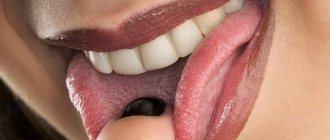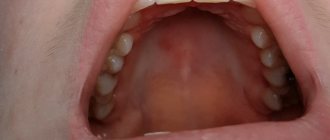Glossitis , a disease or inflammation of the tongue, is subjectively perceived as an extremely unpleasant and often complicated phenomenon. The tongue feels like it is burning, bitten, itchy, or wounded. But often this is not the only symptom; patients simultaneously complain of the same sensations on the oral mucosa, on the palate, on the inner surface of the cheeks. The tongue and mucous membranes have an unusual appearance, for example, strange spots on the tongue . Sometimes the sense of taste is impaired and dry mouth appears. And at the same time, it is often difficult to make a quick and accurate diagnosis.
Tongue diseases , glossitis, if they are not mechanical tissue damage, are usually infectious inflammatory processes (local) or symptoms of other diseases. Glossitis is sometimes considered a special case of stomatitis, but is always considered separately.
Symptoms of tongue diseases, glossitis
As a rule, the symptoms of glossitis extend not only to the tongue area, but also to the palate and even lips. Patients complain of pain such as a “burnt” tongue, lack of normal taste sensations and decreased salivation.
But the symptoms of tongue disease can vary in severity and location. Initially, spots on the tongue may be on the side and on the tip, and the pain is periodic (for example, absent at night), but then becomes constant.
Tongue diseases can have a wide variety of causes and can therefore be accompanied by many other symptoms. Redness with spots on the tongue , swelling, bleeding indicate inflammatory causes. If the mucous membrane of the tongue has a whitish color, then this most likely indicates a fungal infection ( candidal glossitis ) or leukoplakia. Visible symptoms may even be absent if, for example, the disease has a psychosomatic cause (that is, the interaction of physiological and mental factors). Another example: if at the same time there are complaints of numbness in the limbs, then this may be a sign of diabetes.
Diagnostics
The cause of the symptom is determined by the dentist. If there are indications, patients are referred for consultation to a gastroenterologist, therapist, neurologist, and other specialists. The doctor determines when the pain first appeared, what symptoms were accompanied, and how the disease developed. To clarify the diagnosis, the following procedures are performed:
- Inspection
. During the physical examination, general changes are sometimes detected (for example, pale and dry skin with anemia). When examining the tongue, swelling, hyperemia, discoloration, the presence of erosions, ulcers, and infiltrates may be detected. With neuralgia, areas of pain indicate damage to one or another nerve. During a dental examination, carious teeth, defects in dentures and orthodontic structures may be detected. - Instrumental techniques
. To exclude xerostomia and assess the condition of the salivary glands, sialography and ultrasonography are recommended. If gastrointestinal pathologies that provoke glossalgia are suspected, esophagogastroduodenoscopy and a contrast study of the stomach are performed. For neuralgia, electromyography is indicative. - Lab tests
. Confirm the presence of pernicious or iron deficiency anemia. As part of the differential diagnosis, saliva is examined. In case of candidiasis and bacterial lesions, the discharge is inoculated onto nutrient media. For viral infections, PCR is performed.
Causes of glossitis
Conventionally, the causes of tongue diseases can be divided into local (primary glossitis) or general, that is, they can be classified as symptoms of other internal diseases (secondary).
Local (local) reasons. Among them are bacterial (mainly streptococcal), viral (mainly herpes) or fungal (candida) infection. These same types of infection lead to the development of various lesions of the oral mucosa. Local causes of tongue disease can also include various injuries to the tongue with subsequent inflammation (for example, burns, injury from orthopedic and orthodontic structures) or local allergic reactions (for example, initiated by components of dental crowns or filling materials, such as contact allergic stomatitis).
General pathologies and diseases. Glossitis as one of the symptoms can manifest itself in the presence of deficiencies in the body (vitamin B, iron), diabetes mellitus, some common infectious diseases, anemia (in particular, vitamin B12 deficiency), general allergic reactions (for example, allergies to certain foods nutrition), diseases of the stomach and intestines, when taking certain medications (antibiotics, etc.), for diseases such as measles, diphtheria, scarlet fever.
Specific psychological reasons. Their role in the appearance of apparent diseases of the tongue is often underestimated, and, nevertheless, symptoms of depression sometimes manifest themselves not only in psychological symptoms, but also such as headaches, loss of appetite due to apparent pain in the tongue. An imaginary burning sensation in the tongue can be caused by fears of cancer (cancerophobia) and states of psychological stress, often with parallel dysfunction of chewing function.
Prevention
To avoid the reappearance of small red dots on the tongue, you must carefully follow a number of recommendations:
- Eliminating bad habits.
- Scrupulous personal hygiene of the oral cavity, as well as good quality toothpaste and brushes.
- Review your diet and get rid of fast food products that are rich in hot spices.
- Carbonated drinks should not be consumed, especially if they contain a large number of dyes.
- Strengthening the immune system.
- Periodic visits to the doctor.
- It is recommended to harden children, carefully choose a diet, and also exclude the intake of any allergen.
Classification and forms of the disease
Due to the mass of causes that cause tongue diseases, a detailed classification is difficult. But usually, based on the nature of the symptoms and the course of the disease, the following forms of the disease are distinguished.
Catarrhal glossitis. The process of inflammation is localized on the surface of the tongue (mucous membrane), but the inflammation can pass, while remaining superficial, into an ulcerative or aphthous form (like ulcerative stomatitis or aphthous stomatitis).
Deep glossitis. The process affects the deep layers of the tongue, adjacent tissues of the oral cavity and even lymph nodes. Characterized by increased body temperature, deterioration in general health (weakness), breathing problems, headaches and severe throbbing pain in the tongue.
Chronic glossitis. The catarrhal form can become chronic in the absence of treatment, reduced immunity, or the presence of autoimmune pathologies. The chronic form is characterized by persistent, dense swelling, changes in tissue structure up to the appearance of growths.
Treatment methods
Treatment of glossalgia begins with sanitation of the oral cavity: the doctor will prescribe treatment for caries, replacement of incorrectly installed dentures, as well as replacement of fillings that have expired. Making new dentures allows you to create the correct bite height. Also, at the same time, it is necessary to visit other specialists of a narrow profile - a neurologist, endocrinologist, psychotherapist, etc.
The main treatment tactic is to influence the links of the pain symptom. So, the doctor may prescribe bromine, iron, tranquilizers, and sedatives. B vitamins and lingual nerve blocks may be recommended to help restore normal function.
If the mucous membranes are dry and there is insufficient salivation, the doctor will prescribe a vitamin A solution or another product to moisturize and stimulate saliva production.
Reflexology and physiotherapeutic methods can be used as an addition to the main course of treatment. If suspiciousness, increased anxiety, or depression are present, then working with a psychotherapist is indicated.
General recommendations include the following:
- A gentle diet - eating soft foods, avoiding sour, salty, fatty foods, spices and seasonings.
- Normalization of neurological status if necessary. As prescribed by a neurologist or psychiatrist, you can take antidepressants, anti-anxiety medications, nootropics, and drugs to improve sleep.
- Psychotherapy according to indications. In some cases, good results can be achieved with the help of short-term or long-term psychotherapy.
It is important to be attentive to your psycho-emotional state. Relaxation methods, development of stress resistance, and breathing exercises may be recommended to bring the psychological state into balance.
There are also special forms of the disease
Desquamative glossitis (“geographic tongue”). Red spots on the tongue (focal disruption of the epithelium), grooves and lines resembling the outlines of continents on a geographical map. The exact cause is not yet known, but it is more often observed in pregnant women, with pathologies of the gastrointestinal tract, blood and liver diseases. Usually does not develop into an acute form.
Folded glossitis. Congenital anomaly of the tongue. Characteristic are symmetrical folds on the front and middle parts of the surface. It usually does not interfere with the functions of the tongue, and treatment is carried out for aesthetic purposes only. But folds can contribute to the accumulation of various pathogenic microorganisms, so careful oral hygiene is recommended.
Diamond-shaped glossitis. A consequence of thickening of the epithelium in the basal region and the formation of diamond-shaped areas. It often has a chronic and recurrent course, and some of its types require special treatment.
Why do red dots appear?
Red dots on the tongue most often appear with stomatitis (inflammatory processes of the oral mucosa). There are quite a few direct causes of the development of stomatitis, but most often it is a viral infection, for example, of a herpetic nature.
Other factors also include pathogenic bacteria (streptococci, staphylococci), poor nutrition, fungi (for example, candidiasis), thermal or mechanical injuries, side effects of a number of medications, anemia, hormonal imbalance, decreased salivation, and dehydration.
The next common cause of red dots is allergies. It most often differs in food origin. You can suspect it when keeping a food diary. In this case, it is convenient to note the relationship between the appearance of a rash and the use of a specific product.
What are the reasons for red dots and white coating on the tongue? More on this below.
The mechanism of occurrence and symptoms of stomatitis
As noted above, the symptoms of stomatitis are ulcers that appear in the oral cavity (on the palate, in the cheeks or on the tongue), which bother a person, causing him pain. The mechanism of occurrence of such erosions is associated with the response of the human immune system to foreign irritants, which, for example, are viruses or bacteria.
Stomatitis manifests itself in such forms as herpetic, aphthous, allergic, vesicular, catarrhal, etc. In any case, the manifestations of stomatitis disease are expressed in lesions of the human oral mucosa or tongue, only depending on the variety they are of a different nature.
Bald
Normally, the lingual surface is covered with a large number of small taste buds, which give it a velvety appearance. If such papillae die or atrophy for any reason, “bald” spots appear. They are pink in color, irregular in shape and do not spread to the mucous membranes of the cheeks, lips or gums.
Reasons that can cause the appearance of such pink “bald” spots:
- Inflammatory diseases (glossitis, stomatitis).
- Tongue injuries.
- Burns from heat or chemicals.
“Bald” spots do not cause any inconvenience to children, but may slightly change the taste sensations. It is impossible to cure such formations, since the taste buds cannot be restored.
If you find that your one-year-old or older child’s tongue has become spotted, you should not panic and try to treat it yourself. Also, the appearance of spots on the tongue should not be ignored, as they may indicate the presence of serious diseases. It is necessary to consult a doctor who will find out the exact cause of such changes and, if necessary, select appropriate treatment for the child.
Like a burn
In order for a burning sensation to appear in the mouth and tongue, it is not at all necessary to burn yourself with hot food or drink. Why else may you experience pain and irritation:
- Due to injuries (including dentures or chips on the teeth, existing deposits on the surface of the teeth - tartar, etc.). In particular, if there are any protrusions and defects on the tooth enamel, the tongue reaches out to them in order to scratch continuously. Of course, this leads to microtraumas.
- Due to inflammatory lesions of the oral cavity, represented by glossitis, stomatitis, etc.
- Due to diseases of the digestive tract. Surprisingly, serious pathologies of the gastrointestinal tract lead to changes in the normal state of the tongue. This organ may become coated with an abnormal color, become swollen and painful. The patient may experience a burning sensation in the mouth. But in addition to such symptoms, there are also manifestations of the underlying disease.
- Against the background of a lack of various nutrients. Most often, iron and vitamin B12 are the culprits of the ailment. With a severe deficiency of these substances, the tongue becomes smooth, changes color, and becomes coated. Quite often there is an increase in the size of such an organ and its pronounced pain.
- Due to neuralgic ailments. A burning sensation on the tongue, severe rawness and tingling can be explained by damage to the nerves that innervate the tongue and mucous membranes of the entire oral cavity. In this case, there are no visual manifestations of malaise. Patients may feel dry mouth and complain of rapid fatigue when talking. The disease can subside and awaken, for example, with anxiety, overwork, public speaking, etc. Doctors classify this condition as glossalgia.
- The burning and tingling of the tongue that occurs the next morning can be explained by involuntary clenching of the teeth during the night's rest. This pathology is classified by doctors as bruxism, and if left uncorrected, it can lead to serious dental problems.
If there is an unpleasant sensation in your tongue, as if it is burned, you should not self-medicate.
To identify the cause of this problem, you need to consult with a therapist, otolaryngologist and, possibly, a dentist.
White
In a baby, the appearance of white spots on the tongue most often indicates thrush - a fungal infection of the mucous membranes due to a decrease in immune defense in the body or when taking antibiotics. Such spots are located asymmetrically, can have a variety of sizes, and are often covered with a cheesy coating.
If a child shows signs of thrush on his tongue, then it is necessary to visit a pediatrician who will find out the reasons for its appearance. Delay in treatment can cause progression of the disease and inflammation of the mucous membrane, which will cause pain and discomfort in the child. You cannot try to remove the plaque on your own; this can lead to additional trauma. To eliminate such white spots, it is most often recommended to treat the child’s oral cavity with a weak solution of baking soda or ordinary brilliant green. In more severe cases and with relapse of the disease, it may be necessary to take antifungal drugs.









